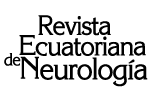|
ISSN 1019-8113
print version
| >
INSTRUCTIONS TO AUTHORS • Scope of application and policy • Form and preparation of manuscripts • Submission of manuscripts |
Scope of application and policy
|
|
The Ecuadorian Journal of Neurology accepts for publication scientific papers on all branches of neuroscience, and includes the following sections on a regular basis: Original Articles of clinical or experimental research, Review Works, Clinical Case Reports and Letters to the Editor. In addition, the reports of congresses or neurology courses held in the country and general information on the activities of the Ecuadorian Society of Neurology and the League Against Epilepsy will be published. |
|
Form and preparation of manuscripts
|
|
The authors must comply with the following standards in the preparation of manuscripts: A. Manuscripts must be made in Microsoft Word. The document must be sent along with the tables and figures corresponding to the email: revecuatneurol@gmail.com. B. The initial page must contain the title of the work in Spanish and English, which must be short and specific, as well as the full name of the authors, their most important academic degree, the institution to which they belong and the full address of the author who will be in charge of correspondence concerning said article. To avoid confusion with the name of the authors at the international level, the paternal and maternal surname - in case you want to include it - will be linked by a script. C. The Original Articles must include, in the 2nd. page, a summary of 200 words or less, in which the objective of the work, its results and the main conclusions are emphasized. The abstract must be sent in Spanish and English. The review works and the reports of clinical cases should also have a summary, whose extension will depend on the size of the manuscript. D. The Original Articles must have the following sections: Introduction, Materials and Methods, Results and Conclusions. Its length must be no more than 30,000 characters, including spaces, title, summary, tables, figures and appendices. A maximum of 6 figures and 3 tables can be included. E. The Clinical Case Reports should include a brief introduction, a full description of the case and a final comment on the relevant aspects of the case. Its length must be no more than 20,000 characters, including spaces, title, summary, tables, figures and appendices - up to 3 figures and 2 tables. F. The format of the Review Works is at the discretion of the authors, but with a maximum length of 40,000 characters, including spaces, title, summary, tables, figures and appendices. Up to 6 figures and 3 tables will be accepted. G. Letters to the Editor are welcome. They must be written in double spacing, and no more than 300 words. They can include a figure and up to five bibliographical references. They will deal with general neurological issues or with comments on articles published in previous issues of the journal. H. Tables should be included in a separate page, numbered consecutively according to their location in the text. They should carry a concise explanatory foot. The excess of tables will be avoided, avoiding repeating in the text what is expressed in them. If the tables have been made in Excel, the original documents must also be attached. I. The graphics and photographs must be sent separately, in JPEG or EPS format, and in high resolution (300 dpi) - they should never be included in the Microsoft Word document - in a size not less than 10 cm wide, and they must be clearly identified with the number of the figure and the corresponding legend. If the graphics have been made in Excel, the original documents must also be attached. The captions must be in a separate Microsoft Word document. It is recommended to use only those photographs that contribute significantly to the text. Color photographs will be accepted if they provide data that can not be revealed in black and white photographs. Photographs in which data appear that allow the personal identification of certain patients must be accompanied by written consent on the part of said patients. It is not enough to cover the eyes to hide an identity. J. The bibliographical references must be written on a separate page, double spaced, and ordered according to their appearance in the text (not in alphabetical order of the authors). All references must be cited in the text or in the tables, with a number between parentheses, which corresponds to the number in the final list. The authors are responsible for the veracity of the references and their correct transcription. References should follow the style and punctuation of the following examples: References of Magazines: Sommer C, Schroder JM. Hereditary motor and sensory neuropathy with optic atrophy. Arch Neurol 1989; 46: 973-977. Book References: Adams RD, Victor M. Principles of Neurology, 3rd Ed, New York: McGraw-Hill, 1986. K. The received works must conform to the norms described above; otherwise, they will be returned. Once they meet the requirements, they will be submitted for evaluation by the Review Committee, after acceptance for publication. L. Manuscripts that are not accepted for publication will not be returned. The authors will only receive a letter explaining the reasons for non-acceptance, as well as the figures of said manuscript. Authors whose manuscripts are accepted for publication must sign a Certificate of Transfer of Copyrights, which will be sent by the Reviewing Committee. |
|
Submission of manuscripts
|
|
revecuatneurol@gmail.com |
|
[Home] [About the journal] [Editorial board] [Subscriptions]
http://creativecommons.org/licenses/by-nc/4.0/ All the content of the journal, except where otherwise noted, is licensed under a Creative Commons License
San Gabriel y Nicolás Arteta. Torre Médica 3. Piso 2. Consultorio 204 Caixa Postal 170521 CEP Quito, Pichincha, Ecuador Tel.: 5932-3220-190
